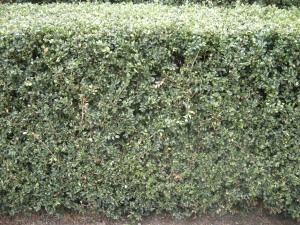Position: Partial shade but will tolerate deep shade to full sun
Soil: Moist, well drained
Flowering period: Mid spring
Eventual Height: 5m
Eventual Spread: 5m
Hardiness: 6a, 6b, 7a, 7b, 8a, 8b 9a
Family: Buxaceae
Buxus sempervirens is a slow growing bushy, rounded shrub with a very dense habit. The leaves are ovate to oblong and a dark glossy green in colour and serrate at the tips. The flowers are insignificant and a green/yellow in colour with no petals. These are then followed by three lobed seed pods containing three to six seeds.
Buxus sempervirens, commonly known as the Common Box, European Box or Boxwood, is native to much of Europe (including the UK), northern Africa and Southwest Asia and has been naturalised in the Americas. The shrub, due to its slow growth rate, also produces very heavy hardwood that makes it ideal for use in cabinet making and is also used as a suitable substitute for ivory. But by far the most prolific use, both historically and in the present, is as a low ‘Box’ hedge and as topiaries.
The etymological root of the binomial name Buxus is the ancient Latin for this species. Sempervirens is derived from the Latin meaning ‘evergreen’.
Buxus sempervirens is useful to the landscape architect mainly for its dense evergreen foliage. It can be clipped into a tight hedge with a very formal appearance and even into sculptural forms. Being native, it is attractive to our native fauna and will attract insects in the spring that pollinate the inconspicuous flowers. It is fully frost hardy and can withstand a hard pruning.
Ecologically, Buxus sempervirens is attractive to pollinating insects.
The Royal Horticultural Society have given Buxus sempervirens their prestigious Award of Garden Merit in 1993.
Buxus sempervirens prefers moist, humus rich, well-drained soils. It tolerates most pH of soil. It will tolerate chalky soils.
Buxus sempervirens maintenance: Young hedging and topiary plants should be cut back by one third during May to encourage bushy growth. Additional trimming may be carried out from May to August as required. Mature hedges should be trimmed twice a year, once in May an once in August. Old neglected plants respond well to hard pruning. This should be carried out during May and these plants may be cut back to within 15-30cm from the ground.





